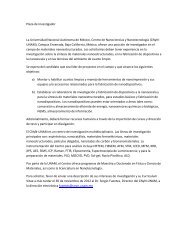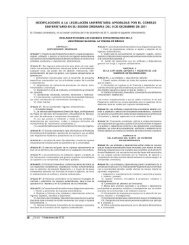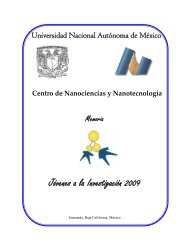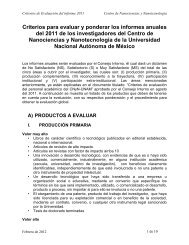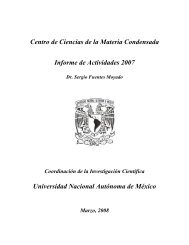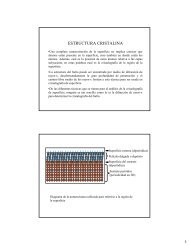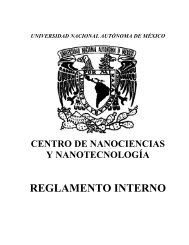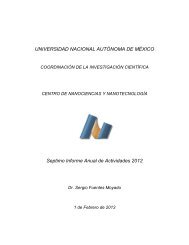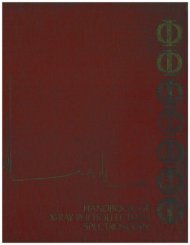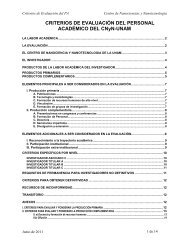Universidad Nacional Autónoma de México - CNyN
Universidad Nacional Autónoma de México - CNyN
Universidad Nacional Autónoma de México - CNyN
Create successful ePaper yourself
Turn your PDF publications into a flip-book with our unique Google optimized e-Paper software.
1st International Symposium on Nanoscience and Nanomaterials<br />
Keywords: 4-nitrophenol, photo<strong>de</strong>gradation, TiO 2 .<br />
The photocatalytic <strong>de</strong>gradation of 4 nitrophenol was investigated using the TiO 2 as catalyst. Different<br />
concentrations of 4 nitrophenol were in use (20 to 200 ppm) used 0.2 g of catalyst for every 100 mL of<br />
solution. The experiments were carried out in a reactor, which consistent of a cylin<strong>de</strong>r constructed of stainless<br />
steel in finished mirror, with 4 lamps of ultraviolet light (UV) of 15 watts (365 nm) and with agitation.<br />
Samples of reaction took to certain intervals of time, the samples were leaked by means of a membrane<br />
Millipore by a diameter of pore of 0.22 m. The taken samples were analyzed by means of a Uv-vis mo<strong>de</strong>l<br />
DR-5000 and for high perfomance liquid chromatography (HPLC) Agilent mo<strong>de</strong>l 1 100. Some samples of<br />
the <strong>de</strong>gradation reaction of 4-nitrophenol was evaluated by UV-Vis spectroscop. These results did not <strong>de</strong>tect<br />
other signals that could be correlated to other species, for which only sees the <strong>de</strong>crease in the intensity of the<br />
peak at 320 nm corresponding to the chemical <strong>de</strong>gradation of the molecule of 4-nitrophenol. The times of<br />
<strong>de</strong>gradation was 300 minutes and observe that in average 90 % of conversion was obtained. Being observed<br />
that the samples to low concentration had a behavior of agreement to a reaction of first or<strong>de</strong>r and those of<br />
high concentration had a trend of or<strong>de</strong>r zero. I <strong>de</strong>tect to him that after 90 minutes intermediary products<br />
appeared, one of which was the hidroquinone. Observed<br />
intermediary.<br />
P-026<br />
that after 90 minutes the turned out to be<br />
SYNTHESIS OF MONO AND BIMETALLIC COLLOIDAL PARTICLES VIA MICROFLUIDIC<br />
MIXER<br />
Brenda Acosta R. 1,a , Viridiana Evangelista H. 1,b Miguel A. Estrada A. 1,c , Martín López C. 2,d , Andrey<br />
Simakov 3,e .<br />
1 Posgrado en Física <strong>de</strong> Materiales, Centro <strong>de</strong> Investigación Científica y <strong>de</strong> Educación Superior <strong>de</strong> Ensenada<br />
(CICESE), Ensenada, B.C., 22860, México.<br />
2 Posgrado en Ciencia e Ingeniería <strong>de</strong> Materiales, <strong>Universidad</strong> <strong>Nacional</strong> Autónoma <strong>de</strong> México (<strong>CNyN</strong>-<br />
UNAM), Ensenada, BC, 22860, México.<br />
3 Centro <strong>de</strong> Nanociencias y Nanotecnología, <strong>Universidad</strong> <strong>Nacional</strong> Autónoma <strong>de</strong> México (<strong>CNyN</strong>-UNAM),<br />
Ensenada, BC, 22860, México.<br />
a bracosta@cnyn.unam.mx, b vevangel@cnyn.unam.mx, c mestrada@cnyn.unam.mx,<br />
d martinlopez@cnyn.unam.mx, e andrey@cnyn.unam.mx<br />
Keywords: Bimetallic nanoparticles, microfluidic <strong>de</strong>vice, Au, Pd.<br />
Nanoparticles have unique properties based on their sizes, shapes, morphology and composition.<br />
Bimetallic nanoparticles, due to their bimetallization, can improve properties of the original single metal or<br />
create new ones. The colloidal dispersions of bimetallic nanoparticles have some advantages, like the<br />
elucidation without the effect of the metal support interaction, in comparison with the supported ones.<br />
Microfluidic <strong>de</strong>vices, <strong>de</strong>signed to manipulate fluids in microchannels, have been <strong>de</strong>veloped to synthesize<br />
nanoparticles with narrow size distribution. This abstract is focused in the mono (Au, Pd) and bimetallic (Au-<br />
Pd) colloidal nanoparticles synthesis carried out by continuous laminar flow via microfluidic systems. The<br />
characterization of the resulting nanoparticles was carried out by TEM and UV-Vis spectroscopy. According<br />
TEM images, a narrow particle size distribution was obtained. The nanoparticles dynamic formation was<br />
38




